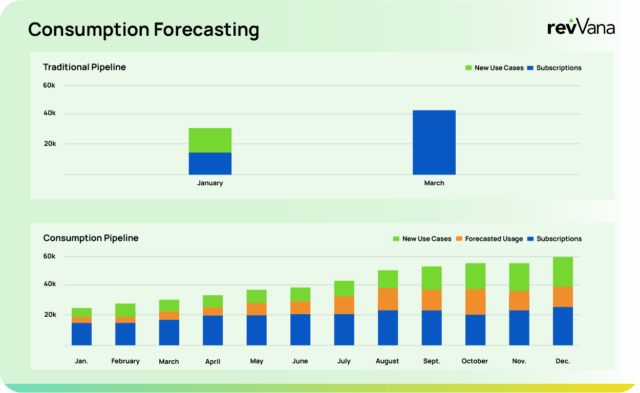Revenue forecasting sits at the core of any growing SaaS or IaaS business. It’s how leadership plans investments, how teams prioritize resources, and how companies communicate confidence to investors. But for all its importance, revenue forecasting is often stitched together from disconnected spreadsheets, rigid CRM reports, and models that fail to adapt as the business evolves.
That gap becomes even more obvious in modern environments, where revenue doesn’t follow a simple, linear path. Some customers are on annual subscriptions. Others scale usage week to week. New products may be billed differently than legacy ones. The more your pricing evolves to reflect customer value, the more your forecasting model needs to evolve with it.
The Challenge with Forecasting in SaaS and IaaS
SaaS and IaaS businesses are inherently multi-dimensional. From flat-fee enterprise contracts to consumption-based pricing and everything in between, the revenue streams aren’t always predictable. They shift with product adoption, contract terms, seasonality, and usage patterns that may not show up in your pipeline until after the fact.
The traditional approach to forecasting typically focuses on bookings. But bookings alone don’t tell the full story. You need to understand how and when that booked revenue actually converts into recognized revenue. For businesses with recurring and variable revenue streams, that can get complicated quickly.
Consider just a few of the layers:
- Subscription revenue that ramps over time
- Multi-year deals with different billing schedules
- Product-led growth motions that start small and scale later
- Usage-based models with unpredictable patterns
- Upsells and renewals that depend on customer behavior, not just rep activity
It’s not enough to know what’s been sold. You need to know how customers will use what they’ve bought, when that usage turns into revenue, and how to spot signals early enough to make strategic decisions.
Why Usage-Based Pricing Increases Forecasting Complexity
For SaaS and IaaS companies leaning into usage-based pricing, the forecasting challenge deepens. The variability that comes with consumption models can’t be managed with static spreadsheets or quarterly updates. One large customer’s usage spike, or slowdown, can materially impact your forecasted revenue in a single quarter.
You might know what was sold, but you’re often missing visibility into what will be used. And usage is what drives revenue in this model.
Here’s what that means in practice:
- Past revenue isn’t always a reliable predictor of future behavior
- Sales pipeline tells part of the story, but product signals carry more weight
- Customer onboarding, activation, and engagement have a direct impact on future revenue, even if the contract was signed months ago
To get ahead of this, companies need to move from a sales-only lens to a more integrated, cross-functional approach. One that connects product usage data, billing logic, and customer lifecycle milestones into a single forecast.
What Modern Revenue Forecasting Looks Like
A modern revenue forecast doesn’t just track ARR or bookings. It combines multiple data sources, adjusts dynamically, and reflects the full complexity of your business model.
That means:
- Tying revenue expectations to both pipeline movement and actual product usage
- Forecasting different types of revenue separately, then rolling them up into a holistic view
- Using historical cohort trends to model adoption, retention, and expansion
- Updating forecasts continuously based on new data, not just at the end of the quarter
In short, modern forecasting is iterative. It learns. It adapts. And most importantly, it reflects what’s actually happening in your business, not just what was entered into the CRM.

How revVana Helps
revVana was built for this new complexity of revenue forecasting. Native to Salesforce, our platform helps teams move beyond pipeline forecasting and toward a complete, real-time view of expected revenue across every stream.
Whether your company sells through flat-rate subscriptions, tiered pricing, usage-based models, or a combination of all three, revVana helps you model revenue based on how it will be earned, not just how it was sold.
Here’s how we do it:
Revenue Schedule Modeling
We allow teams to set different revenue recognition schedules based on product type, contract terms, or billing logic. That means subscription ramps, delayed starts, usage-based triggers, and even custom schedules can all be forecasted and tracked accurately.
Multi-Source Data Integration
revVana connects your CRM, finance, and product usage data. So when customer behavior shifts, your forecast reflects it. No guesswork. No lag.
Scenario Planning and Versioning
Run different forecast versions for leadership, finance, or board reporting. Test what happens if a key customer accelerates usage or if churn ticks up. Build a plan that’s flexible, not fragile.
AI-Driven Predictive Forecasting
We use machine learning models to analyze historical patterns, product adoption trends, and renewal cycles to generate more reliable forecasts, especially for variable revenue streams.
SaaS and IaaS businesses have never been more dynamic. With flexible pricing models, evolving customer behaviors, and increasingly complex revenue streams, forecasting requires more than static tools and end-of-quarter check-ins.
It requires a system that adapts to how your customers buy and use your products. A system that reflects reality in real time. And one that enables your teams to plan with confidence.






